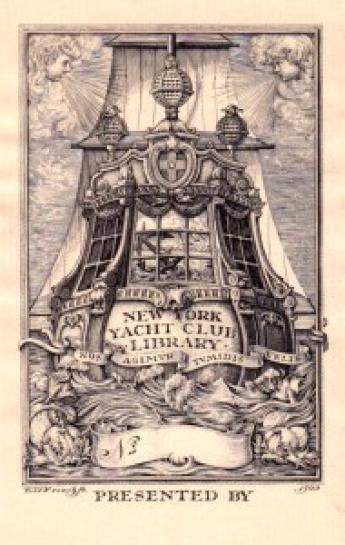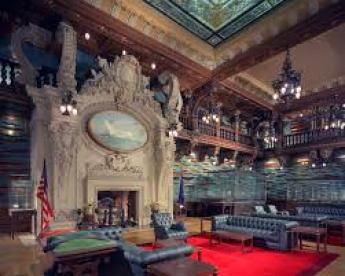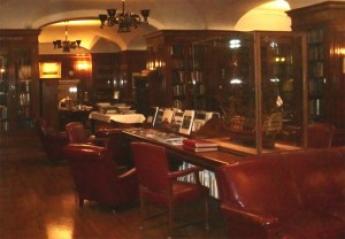Antiquarian Booksellers' Association of America Ten Pound Island Book Company
Thanks, Bruce McKinney!

By Greg Gibson
Every once in a while we encounter events that we know will be benchmarks in our careers as antiquarian book dealers. The first shop, with its smell of fresh cut pine shelving, the first big buy, the first book fair, the biggest book fair, the biggest buy, the luckiest find, the first whale (dealer slang for a big buyer) … all these things will be chapter titles in the book of our days in the trade, written out as memoirs, or only recollected as memories. To their number must be added appraisals (for those of us who engage in such shenanigans) – the first one, the biggest one, the one that was challenged by heirs or IRS. The best one. I spent last week on a new chapter in my book of memories. It will filed in my memory bank as “Appraisals, Best.”
Every ten years the New York Yacht Club updates the appraisal of their library for insurance purposes. This decade I got the gig.
Before I go into methodology, I just want to say what a wonderful experience it was. They gave me a room, they paid me well, and they fed me. Like many enclaves of the wealthy, what they promise is exclusivity (“We had a reporter in here when we opened,” my guide told me, “there hasn’t been another one since.”) None but the chosen few get in. But once you’re in, everyone is as friendly as can be. Big hellos from the desk and door people, relaxed, cordial chat from the curatorial staff. Them rich folks sure knows how to live! I put in long hard days, but the evenings were my own. I visited friends and ate well, spending a good part of the money I’d saved in hotel bills feeding my face.
Anyway, I had 10,000 books from the 2004 appraisal to re-evaluate, and three and a half days in which to get the job done. This, of course, was impossible. So I eliminated 8500 of those books by declaring that, owing to the Internet, as many of the books below a certain value (say, $150) had declined in value as those that had risen in value. For purposes of replacement cost, we could decide that the losses cancelled out the gains, and that therefore we could keep the values assigned to them ten years earlier. Besides, those books probably constituted 5% of the total value of the collection. Aside from a scan of the shelves to weed out the more valuable ones (a few $2000 items still remained in the reading room) there was no need to spend any more of my precious time there. That took care of the books in the main library.
The other 1500 or so were kept in a climate controlled rare book vault. First I performed an item by item check on these books to insure that they were where they were supposed to be, or that they were there at all. In the course of this operation I flagged the items most likely to have risen in value, and assigned them new replacement values. Then I sorted the rare book catalog by value, descending, (the librarian had emailed it to me in spreadsheet form) and worked through several hundred of the most valuable items listed in the old appraisal, making sure I hadn’t missed anything my first time through, continuing to assign new values.
It was a blast. As you might imagine, wealthy members had, over the years, donated some rare and marvelous things. Most of the classic yachting books and voyages by sea were there, as well as a generous sprinkling of books that fit into the “hair-raisingly rare” category.
In 1995, or even 2005, this would have been a tedious job, despite the excitement of new discoveries. I would have recorded the particulars of the item in question and then at a later time I’d have gone through auction records and bookseller catalogs in search of comparable sales. In many cases, having failed to quickly find any, I’d have made an educated guess.
In 2015 I turned on my laptop and opened up the spreadsheet catalog. Then I got online and went to the Rare Book Hub database – containing 5.8 million records of books sales (thanks, Bruce McKinney – and I mean it!), ViaLibri, American Book Prices Current, Worldcat, catalogs of several other pertinent institutions, and my own proprietary database, compiled over twenty-five years, of tens of thousands of sales and listings from my own and other maritime dealers’ catalogs. The process wasn’t instantaneous, but I was able to get a pretty accurate reading, right then and there, of the way any given book was trending.
As I said, the low end, out in the reading room, hadn’t changed much. The high end, in the rare book vault, had taken off like a rocket. This was nothing we hadn’t known before, but it was fascinating to see proof of it, over and over again.
The most challenging part of the job was the dress code. I had to Google “business casual” then spend hours of personal wardrobe analysis to make sure I got it right. It was only after I got there that I discovered that nobody cared what I was wearing. It was August. They were all out on their yachts.
***
Posted on Bookman’s Log, presented here by permission of the author. Pictures: Bookman’s Log.



